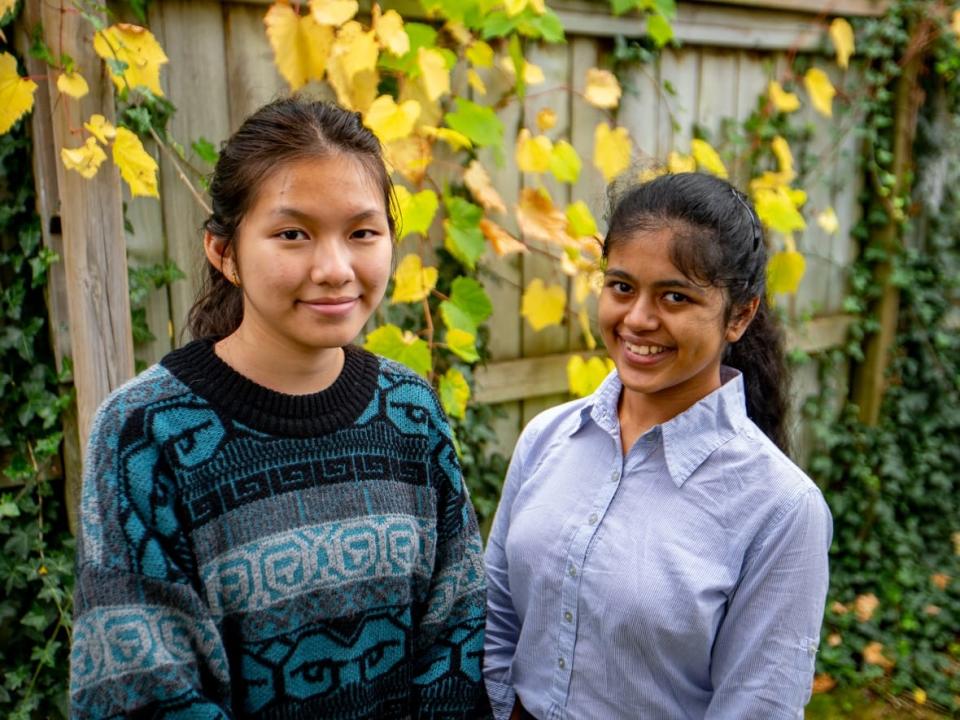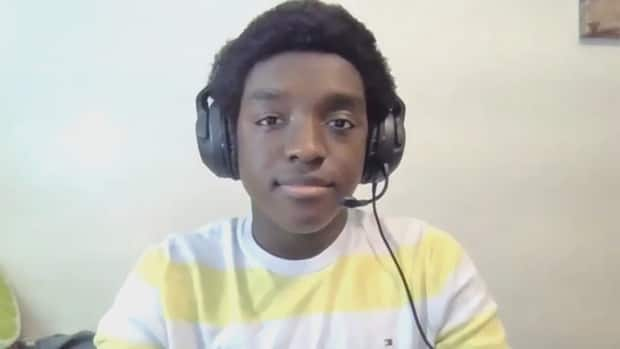High schoolers, educators decry split focus of hybrid learning model

After a Grade 10 year with province-wide shifts to virtual learning, Evelyn Jia was eager to be back at school in person this fall.
However, the 16-year-old and her peers continue to struggle with their schooling daily, she says, because her Mississauga, Ont., school board has opted for a hybrid learning model: with one teacher simultaneously instructing in-person students and those logging on from home.
Teachers fiddling with the additional technology needed for incorporating remote students coupled with recurring connectivity issues eat up a lot of time, says Evelyn. As a result, class isn't productive for those at school nor those at home.
Take chemistry.
"The teacher has five screens up, two mouses and two keyboards — and it takes her half an hour to set it up," Evelyn said. "That's half an hour of class time that we could be using to be learning chemistry."
Familiarity, flexibility cited as advantages
Ontario school districts using the hybrid model of simultaneous instruction this year say it's the way to keep remote learners connected to familiar teachers and their regular school communities. It also allows for greater flexibility if sudden shifts between in-person and remote learning are required.
However, the model — which some boards adopted to address the ongoing provincial mandate requiring them to offer virtual learning — continues to draw fierce criticism from students, parents, educators and more, who blast its sustained use this year as unacceptable at this point of the pandemic.
Grade 11 student Kaden Johnson notes the uphill battle remote students have attempting to learn virtually alongside in-person peers.

"Sometimes, the audio doesn't work, so we can't hear people," said the 16-year-old Mississauga student. "The teacher has to try and fix that and their in-person students have to just sit there and wait. [Meanwhile], we don't even know what's going on if there's no Wi-Fi at the school.
"If I fall behind or if I make mistakes, I can't always get back to where I was before or even where I could have been."
'Always feel like you're neglecting someone'
This marks the third school year students have experienced at least partial disruption to their education because of the pandemic.
For Rachna Venkatesh, Grade 9 was the last time she had a full, normal year of high school. Now in Grade 12, she worries about the "compromised learning" students have faced under the hybrid model, especially as she prepares to shift to post-secondary studies.
"I'm looking at doing health sciences in university, and if I'm not able to understand a lot of the content being taught because of all these issues of hybrid learning, then when I go into my first year of university, I will be sort of falling behind," said the 16-year-old, who attends the same school as Evelyn.
WATCH | Science teacher explains how hybrid can lead to inequitable learning:
High school science teacher Jason Bradshaw echoes these student concerns. He teaches in the Peel District School Board in Mississauga and tries to prepare engaging classes for his in-person and remote students, but it's often an impossible task.
"It's taking me at least twice as long in the morning just to get my classes set up," Bradshaw said.
In addition to setting up regular labs and experiments before classes start, he must also connect all his online "production" gear, which includes computers, a web cam and a tablet.
Then, if he suddenly loses connectivity to his learners at home, he has to quickly troubleshoot.
"Meanwhile, the kids in-class? I have to keep them engaged and occupied," Bradshaw said. "It's really the job of at least two people, maybe three people, if you consider the tech support that's involved. But you have to try and do it on your own."
While much attention has been paid to the difficulty younger students have under the hybrid model, Bradshaw points out that high-schoolers, especially those in a key transition year such as Grade 9, are also at a critical period of learning.
"They still need and deserve a teacher who's going to be giving them their full attention, especially doing challenging subjects like trying to learn science and chemistry," he said.
"They're not getting the best that we teachers would like to be able to offer. You always feel like you're neglecting somebody in this hybrid model because you can't possibly be in two places at once."
'Minimize disruption and maximize safety'
Peel District School Board cited "pedagogical, social and health and safety benefits" for its adoption of hybrid teaching for secondary students. These include being taught by the same educator whether learning in person or online, as well as continuity of learning for students suddenly sent into isolation because of COVID-19 exposure or if schools are directed to virtual learning by public health officials or the Ministry of Education, the board said in a statement.
Similar reasoning was offered by York Region District School Board, which is using hybrid in both elementary and secondary schools.
A spokesperson cited "feedback from families" wanting to stay connected to their local community school and the flexibility to move between in-person and online classes among the main reasons for its adoption of hybrid.
The board said its decision was also influenced by "conversations with employee groups," ongoing infection prevention and control measures and the need to adhere to government funding allocations.
For its part, the Ontario Ministry of Education said the goal for this school year was "to minimize disruption and maximize safety" in its overall reopening plan.
The government "recognizes that returning students to full-time, in-person learning is key for their health and development," said Caitlin Clark, a spokesperson for Stephen Lecce, Ontario's education minister.
However, "in order to best respect and support the choices of families, remote learning will continue to be offered for this school year," she said.
Remote option 'on the cheap'
Ultimately, the persistence of the hybrid model is a consequence of funding decisions made at the provincial level, says Bonnie Stewart, assistant professor of online pedagogy and workplace learning in the University of Windsor's faculty of education.
"Almost nobody is choosing hybrid because it's the optimal learning situation," she said. "It's being chosen because it's financially viable: boards can afford to do it because they're getting teachers to do two jobs at once.
"When you refuse to fund virtual, but you mandate school boards to offer virtual, you are basically setting up a situation where you're asking them to do what they can do on the cheap."
WATCH | Why the current hybrid system makes it 'really, really easy' to lose track of students:
Hybrid originated as HyFlex (hybrid-flexible), first introduced for small classes of adult graduate students as a flexible option for those who might need to log into class remotely or perhaps at a later time altogether because of parental or other responsibilities, Stewart explained.
Online education of this sort requires both significant financial investment and specialized teaching.
"In Ontario schools, we don't have a flex situation. What we have is a collapse of basically two totally separate class responsibilities into a single model for a single teacher, and it reduces the learning situation to a broadcast," Stewart said.
"The hybrid situation is not a prioritization of learning or of education in any sense."
Despite push back against the model, including recent protests in Toronto and York Region, school board officials have not budged on the issue.
"With all the attention that we've brought to this topic and how much we've addressed it, the fact that the hybrid system has remained in place for so long really doesn't feel like we're being listened to," said Grade 11 student Kaden Johnson.

 Yahoo Movies
Yahoo Movies 